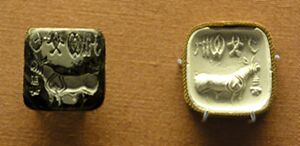Stamp seal facts for kids

The stamp seal (also impression seal) is a common seal die, frequently carved from stone, known at least since the 6th millennium BC (Halaf culture) and probably earlier. The dies were used to impress their picture or inscription into soft, prepared clay and sometimes in sealing wax.
The oldest stamp seals were button-shaped objects with primitive ornamental forms chiseled onto them. The stamp seals were replaced in the 4th millennium BC by cylinder seals that had to be rolled over the soft clay to leave an imprint. From the 12th century BC the previous designs were largely abandoned in favor of amphora stamps. Romans introduced their signaculum around the first century BC; Byzantine maintained the tradition in their commercial stamps.
In antiquity the stamp seals were common, largely because they served to authenticate legal documents, such as tax receipts, contracts, wills and decrees. They are extensively researched because they were usually carved with important "themes" of the society that produced them, rather than with an ordinary signature.
Indus stamp-seal
Different from the Minoan stamp-seals, the Indus stamp-seals probably have a different function from the stamp seals of the Minoan civilization, as they typically have script characters, with still undeciphered associations.
Gallery
-
Stamp seal of an Egyptian named:
Meru-the Answerer of Horus
(Brooklyn Museum)
See also
- Ancient Near Eastern seals and sealing practices
- Bulla (seal)
- Indus script
- LMLK seals from Lachish, ca 700 BCE.
- Scaraboid seal






